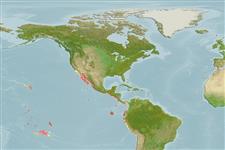Ελασμοβράγχιοι (καρχαρίες και σαλάχια) (sharks and rays) >
Myliobatiformes (Stingrays) >
Dasyatidae (Stingrays) > Dasyatinae
Etymology: Dasyatis: Greek, dasys = rough, dense (Ref. 45335).
More on author: Garman.
Issue
This species is synonym of Dasyatis dipterura Jordan & Gilbert, 1880. See nomenclatural details in Eschmeyer (CofF ver. Oct. 2012: Ref. 92135). The species page will be removed.
Environment: milieu / climate zone / depth range / distribution range
Οικολογία
Θαλασσινό(ά) βενθικό(ς); εύρος βάθους 1 - 70 m (Ref. 37955), usually 1 - 17 m (Ref. 9254). Subtropical; 42°N - 19°S, 161°W - 70°W
Eastern Pacific: Hawaii and from California, USA to Peru.
Μέγεθος / Βάρος / Age
Maturity: Lm ? range ? - ? cm
Max length : 187 cm TL αρσενικό/απροσδιόριστο; (Ref. 40637); common length : 120 cm TL αρσενικό/απροσδιόριστο; (Ref. 9254); μεγ. δημοσιευμένο βάρος: 46.3 kg (Ref. 40637)
Found in bays, in sea grass beds, kelp beds, and near reefs on sand and mud bottoms (Ref. 12951). Digs in the sand to feed (Ref. 5227). Feeds on small fishes, crabs, clams, and other benthic invertebrates (Ref. 37955). Ovoviviparous (Ref. 50449). Venomous spine on tail.
Life cycle and mating behavior
Γεννητική Ωρίμανση | Αναπαραγωγή | Γεννοβολία | Αβγά | Γονιμότητα | Προνύμφες
Exhibit ovoviparity (aplacental viviparity), with embryos feeding initially on yolk, then receiving additional nourishment from the mother by indirect absorption of uterine fluid enriched with mucus, fat or protein through specialised structures (Ref. 50449). Distinct pairing with embrace (Ref. 205).
Nishida, K. and K. Nakaya, 1990. Taxonomy of the genus Dasyatis (Elasmobranchia, Dasyatidae) from the North Pacific. In: Pratt Jr., H. L., S. H. Gruber and T. Taniuchi (eds.): Elasmobranchs as living resources: advances in the biology, ecology, systematics, and the status of the fisheries. NOAA (National Oceanic and Atmospheric Administration) Tech. Rept. NMFS 90:327-346. (Ref. 7445)
IUCN Red List Status (Ref. 130435)
Threat to humans
Venomous
Human uses
Warning: mysqli::__construct(): (08004/1040): Too many connections in /var/www/html/includes/func_getlabel.php on line 46
Can't connect to MySQL database (fbapp). Errorcode: Too many connections
